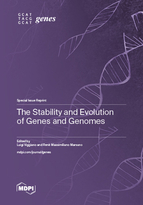The Stability and Evolution of Genes and Genomes
A special issue of Genes (ISSN 2073-4425). This special issue belongs to the section "Molecular Genetics and Genomics".
Deadline for manuscript submissions: closed (20 August 2022) | Viewed by 31779
Special Issue Editors
Interests: evolution; epigenetics; HGT; stem cells; neurodegenerative disorder
Interests: transposable elements; heterochromatin; evolution; Gene Expression; horizontal transposon transfer, mitochondrial biogenesis
Special Issue Information
Dear Colleagues,
Extant species are the result of an arms race between evolutionary processes and the stabilization of the genetic information. A plethora of mechanisms can contribute to the evolution of genes and genomes including mutations, indels, CNVs, chromosomal rearrangements, horizontal gene transfer, and transposition. On the other side, cellular mechanisms that counterbalance excessive variation contribute to the stability of genes and genomes and preserve the faithful pass down of the genetic material from generation to generation. These latter mechanisms include DNA damage surveillance, DNA repair mechanisms, mitotic and meiotic checkpoints, and epigenetic organization of centromeres and telomeres.
In this Special Issue, we aim to collect original research papers and reviews to address the complex dynamics underlying these two contrasting processes using molecular evolution, population genetic, and functional genomic approaches in model and non-model organisms.
Dr. Luigi Viggiano
Dr. Renè Massimiliano Marsano
Guest Editors
Manuscript Submission Information
Manuscripts should be submitted online at www.mdpi.com by registering and logging in to this website. Once you are registered, click here to go to the submission form. Manuscripts can be submitted until the deadline. All submissions that pass pre-check are peer-reviewed. Accepted papers will be published continuously in the journal (as soon as accepted) and will be listed together on the special issue website. Research articles, review articles as well as short communications are invited. For planned papers, a title and short abstract (about 100 words) can be sent to the Editorial Office for announcement on this website.
Submitted manuscripts should not have been published previously, nor be under consideration for publication elsewhere (except conference proceedings papers). All manuscripts are thoroughly refereed through a single-blind peer-review process. A guide for authors and other relevant information for submission of manuscripts is available on the Instructions for Authors page. Genes is an international peer-reviewed open access monthly journal published by MDPI.
Please visit the Instructions for Authors page before submitting a manuscript. The Article Processing Charge (APC) for publication in this open access journal is 2600 CHF (Swiss Francs). Submitted papers should be well formatted and use good English. Authors may use MDPI's English editing service prior to publication or during author revisions.
Keywords
- Gene and Genome Evolution
- Horizontal Transfer
- Transposable Elements
- CNV
- Mutations
- Adaptation
- Euchromatin and Heterochromatin
- Epigenetics
- Chromosome Structure and Stability
- Genome Surveillance







